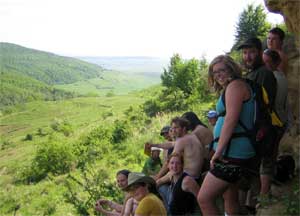 |
| Earth Sciences students pause for a breather on the honours excursion to Romania. (Duncan McLeish photo) |
At Dalhousie, the Department of Earth Sciences has the enviable reputation of arranging the best field trips.
In 2006, students in the honours program traveled to southern Italy to see volcanoes┬áMount Etna and Mount Vesuvius, which destroyed Pompeii in 79 AD.┬áAnd, in 2005, students experienced Chile├Ľs diverse landscapes, ranging from the Andean Mountains in the east to the desert in the north.
This year, the destination was Romania. Professor Nick Culshaw and 18 students took part in the two-week trip. They explored Rosia Montana, the largest gold mine in development in Europe; took a close look at mud volcanoes, tree-stump sized eruptions of gas and water; and hiked the Carpathian Mountains, the major mountain system of Eastern Europe. Along the way, they walked around Bran Castle, briefly the home of the notorious Vlad the Impaler, king of Romania from 1456 to 1462, and the inspiration for Bram Stoker├Ľs Dracula.
Click here for photo essay: Earth Science students explore Romania
├ĺIt├Ľs two weeks of hard-core geology everyday,ÔÇŁ says Duncan McLeish, an Earth Sciences honours student going into his fourth year. ├ĺIt lets us see everything we├Ľve talked about for the past three years.ÔÇŁ
Besides the honours excursion, there are plenty of other field trips for undergraduate Earth Sciences students. Joggins, Lawrencetown Beach, Point Pleasant Park, Tancook Island and Peggy├Ľs Cove are popular destinations. As well, each school year begins with a 10-day field school held at Camp Geddie on the Northumberland Strait, Antigonish Co.
├ĺWe get to see a lot of Nova Scotia and that├Ľs great,ÔÇŁ says Tara Muth, another student who went to Romania. ├ĺBut it├Ľs really important to experience what geology is like in other places. Field experience is so crucial. The whole point of being a geologist is getting out and seeing the rocks.ÔÇŁ
